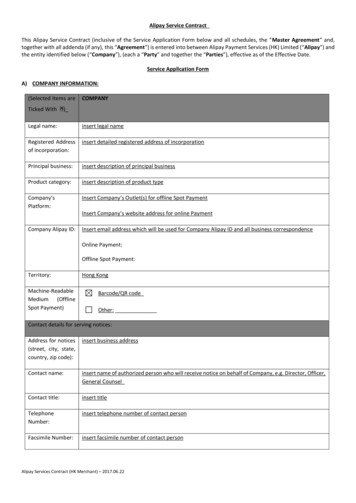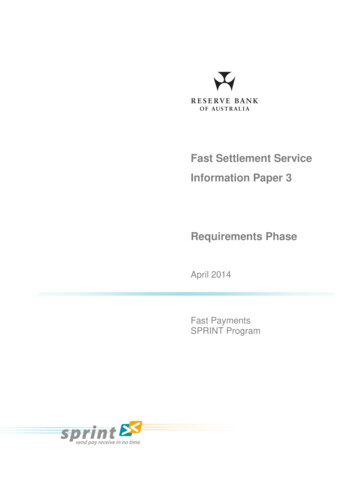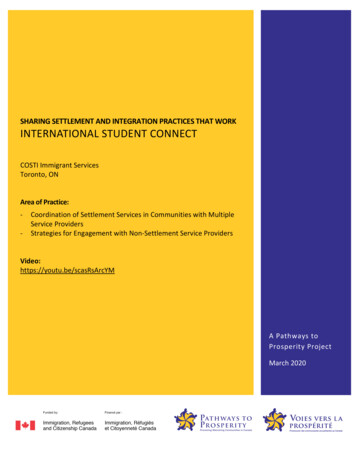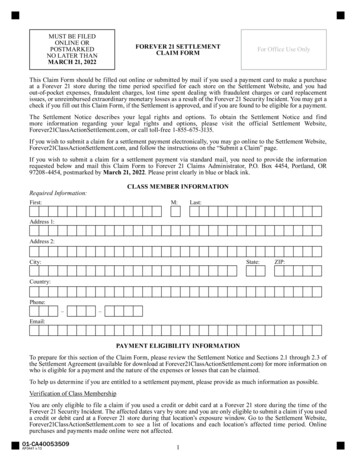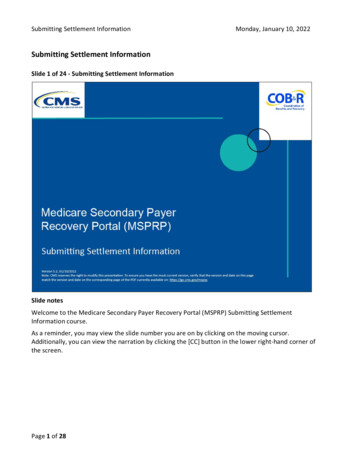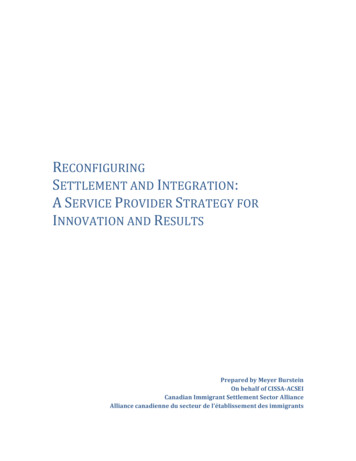
Transcription
RECONFIGURINGSETTLEMENT AND INTEGRATION:A SERVICE PROVIDER STRATEGY FORINNOVATION AND RESULTSPrepared by Meyer BursteinOn behalf of CISSA ACSEICanadian Immigrant Settlement Sector AllianceAlliance canadienne du secteur de l’établissement des immigrants
FOREWORDThis study was commissioned by CISSA‐ACSEI: the Canadian Immigrant Settlement SectorAlliance ‐ Alliance canadienne du secteur de l’établissement des immigrants. CISSA/ACSEIwas formed in March 2005 to represent the immigrant settlement sector and to bring thesector’s expertise to bear on public policies and programs for enhancing the settlement andintegration of immigrants and refugees. CISSA‐ACSEI is dedicated to creating a society inwhich all immigrants and refugees are able to participate fully. The study is consistent withthis objective. Its purpose is to take stock of emerging trends and to map a way forwardthat will allow settlement service providers to acquire the tools and capacities they need topartner with governments in meeting the challenges facing both newcomers and thecommunities in which they settle.The study was made possible by the generous assistance of the provincial settlementumbrella organizations that helped to organize workshops and meetings on behalf of thestudy’s author. As well, thanks is owed to the many service provider representatives,federal and provincial officials and others who agreed to often lengthy interviews andprovided important insights into service delivery and public policy issues.CISSA‐ACSEI commends the study to interested stakeholders as a first, serious step towardsfundamental realignment in how the sector is organized and how it comports itself.Settlement organizations want to play a larger role in shaping and contributing to the futureof Canada. They feel they have a great deal to offer. The study suggests ideas for increasingtheir involvement and influence.Study authorMeyer BursteinMay 16, 2010ii
TABLE OF CONTENTSSectionPagesExecutive SummaryPage 1Chapter 1: IntroductionPage 5Chapter 2: MethodologyPage 8Chapter 3: A Challenging FuturePage 10Chapter 4: Matching RequiredCapacities to Sector StrengthsPage 27Chapter 5: Sector Transformation:Strategies for Change and InnovationPage 40Annex A: Advisory BodiesPage 56Annex B: Interview ListPage 58iii
4
EXECUTIVE SUMMARYThe study – Reconfiguring Settlement and Integration: A Service Provider Strategy forInnovation and Results – was commissioned by CISSA‐ACSEI (Canadian ImmigrantSettlement Sector Alliance). The study is designed to help settlement service providersanticipate new developments and bolster their capacities so they are better able to partnerwith governments and other stakeholders to meet the challenges facing newcomers and thecommunities where they reside. The analysis is based on workshops, focus groups andinterviews with the heads of settlement organizations and ethno‐specific agencies acrossCanada. Interviews were also conducted with senior provincial and federal officials as wellas executives from United Ways and community foundations. Where available, the studytapped academic and government research, including program evaluations and policyassessments.The paper advances the following arguments: That successful settlement and integration measures require governments andsettlement organizations to work collaboratively; That the settlement sector possesses unique skills and knowledge acquired byvirtue of its work with newcomers and institutions that interact with newcomers; That meeting emerging challenges requires precisely those skills in whichsettlement organizations enjoy a comparative advantage; and That there exists a shared interest by governments and the settlement sector inexpanding the sector’s intellectual and mediating capacities, distinct from thesector’s service delivery capacities.The skills and knowledge possessed by settlement agencies are embodied in four strategiccapacities that are unique to the sector. These are: An ability to comprehensively assess client needs and to assemble a bundle ofservices to address those needs, cutting across program silos; An ability to focus on families rather than individuals as the ‘unit of analysis’; A ‘place‐based’ ability to channel services to neighbourhoods and to promote‘bridging’ between mainstream and newcomer communities; and An ability to bring together services in times of crisis.The specialized knowledge possessed by settlement agencies and the trust they enjoyamong newcomers and newcomer organizations can only be acquired tacitly by engaging inintegration activities and mediating relations between mainstream and ethno‐specificorganizations. Settlement agencies solve problems for individual immigrants, immigrantfamilies and communities by creatively assembling government programs and otherstakeholder services. Governments cannot do this because program knowledge is generallysiloed and ministries tend to be unfamiliar with program intersections and interactions.1
The fact that the settlement sector’s strategic capacities must be acquired ‘on‐the‐job’means that the sector’s strengths cannot be replicated by other agencies, thus constituting adurable, strategic advantage.Anticipated challenges and required capacitiesA range of important challenges face settlement practitioners and policymakers. Addressingthese challenges will require capacities that favour the settlement sector Policy reviews point to growing concern with long‐term integration and with socialand cultural goals such as fostering belonging and promoting engagement.Implementing these directions will require assembling a more complex array ofservices for a longer duration. It will also require more attention to localreceptivity. Concern with budgetary deficits will cap or reduce settlement spending, forcingsettlement agencies to compete for support within a shrinking social policyenvelope. Innovation and an ability to leverage support from new sources representcritical responses to anticipated fiscal pressures. Social inclusion will become an increasingly important priority. Immigrant poverty,particularly among visible minority populations in and around major cities,constitutes an existential threat to the immigration program. Combating socialexclusion will require more complex interventions and social bridging. Provincial and municipal interest in immigration is growing, including demands forintegration services in cities with limited integration service capacity. Municipalinstitutions and mainstream organizations will need help from service providers inorder to attract, retain and integrate newcomers. Increases are expected in the flow of highly‐skilled, fully‐fluent immigrants who canbe served by mainstream organizations as well as the flow of lower and mid‐skilledentrants who require the sustained assistance offered by service provider agencies. Increased settlement funding and government willingness to experiment withservice delivery has brought new competitors into the settlement arena. Measuressuch as service vouchers expand this ’threat’.RecommendationsThe report offers fifteen recommendations aimed at clarifying the sector’s strategicdirections and strengthening its strategic capacities. These recommendations are groupedbelow into seven clusters.1. The report places enormous emphasis on expanding the intellectual and analyticcapacities of the settlement sector. This is seen as crucial to promoting socialinnovation. More specifically, the proposed investments in intellectual capacity areessential for capitalizing on the sector’s entrepreneurial abilities, for mobilizing tacitknowledge and disseminating best practices, and for supporting a true partnershipwith government based on mutual respect and expertise. The report argues for thecreation of two key institutions: a sector‐led, pan‐Canadian body comprised of2
settlement agencies and university‐based researchers that would analyze anddisseminate best practice information; and an arms‐length, tri‐partite institution(settlement sector / governments / researchers) that would enjoy a degree ofautonomy and would undertake studies based on independent decisions or inresponse to references by the participating bodies.2. To finance the settlement sector’s intellectual development, the report proposesthree broad changes in existing financial and accountability regimes (recognizingthat provincial differences negate some proposals). Chief among these is theimmediate implementation of the Blue Ribbon Panel’s recommendations onaccountability and financial management. The report also calls for governmentfinancing of corporate activities including research, analysis (of best practices), andstrategic and human resource planning. Lastly, the report recommends thatimmigrant settlement agencies extend the use of cost recovery for the advice theyprovide to public, quasi‐public and commercial organizations. Cost recovery couldtake the form of direct charges to the organizations receiving the advice or costscould be recovered from interested third parties.3. With a view to reinforcing its strategic advantage (a function of its holistic approachto assessing individual and family needs and assembling services accordingly), thesettlement sector should undertake a pan‐Canadian study of the feasibility anddesirability of implementing shared, cross‐agency, needs assessment facilities. Thestudy should advise on the scope of needs assessments; it should propose standardtemplates to capture information; and it should recommend a data system thatwould be useful to clients, agencies and government. In addition, the study shouldexamine the advantages and disadvantages of shared assessment facilities in regardto service specialization and local strategic planning endeavours.4. In order to create a stronger strategic focus, the settlement sector should conduct aninternal study to map the areas in which it enjoys a comparative advantage overmainstream and commercial service providers. This mapping should delineate thenewcomer populations, geographic locations, immigrant services and policy areas inwhich the sector should specialize. Specific topics to be investigated by the studyinclude the sector’s role in providing language and employment services;interactions with immigrant services located in quasi‐public institutions such asschools and libraries; and the cost and service implications of rising proportions ofmulti‐barriered and low skilled clients in settlement agency caseloads. This shift isdriven by policy changes and by program measures that divert easily integratedclients to mainstream agencies, community colleges and commercial operationswhile allocating difficult‐to‐settle residual cases to the settlement sector.5. With a view to strengthening the contribution that settlement agencies make toimproving the receptivity of mainstream organizations to newcomers and tomediating their relations with ethno‐specific associations (including faith‐based3
associations), the settlement sector should strike a task group with government.The task group would document the extensive organizational memberships,advisory roles and public awareness activities of senior agency executives, assessingtheir contribution to the formation of welcoming communities and developingrecommendations for how to promote and better support such activities. A paralleltask group comprised of settlement agencies and ethno‐specific organizationsshould be formed to determine how best to strengthen connections between thetwo sets of organizations and to enhance the collective capacity of ethno‐specificassociations.6. The settlement sector should undertake a careful, pan‐Canadian reassessment of theservices it supplies to temporary workers (and their families) and to long‐timeresidents and citizens. The temporary worker review would assess the impact oftemporary workers on the communities in which they reside; it would clarify thesector’s role in working with employers and municipalities to enhance receptivityand equitable treatment; and it would recommend a set of graduated services forworkers and their families (depending on the likelihood they will remain). Thelong‐time residents and citizen’s review would similarly identify areas ofvulnerability and recommend changes to existing practices, accompanied by ideasfor financing the additional services.7. The settlement sector should undertake a pan‐Canadian review of best practices intwo areas: The first area involves service delivery to remote or under‐servicedlocations. The review would examine the opportunities for service providers toemploy new technologies, to promote self instruction, and to contract for outreachservices by agencies based in larger cities. Special attention would need to be paid toFrancophone minority communities and to the possibility of creating regionalconsortia to deliver services. The second area would focus on pilot projects thatinvolve integrated, community‐led planning aimed at developing more welcomingcommunities. The review would recommend financial, logistical and researchsupports that would allow settlement agencies to play a lead role in local planningconsortiums.4
CHAPTER 1: INTRODUCTIONThe goal of this paper is to ensure that settlement agencies have the capacity to fullypartner with governments in designing policies and programs to meet the emergingchallenges facing newcomers and the communities in which they settle. This is not,presently, the case. While settlement organizations possess major assets ‐ hands‐onexperience, knowledge, commitment and an ability to leverage engagement – they lack themeans to fully capitalize on those assets. This incapacity affects not only the agencies butalso the sector as a whole. What is needed is a new strategy to equip settlement agencies tobuild on their comparative strengths and to enhance their analytic and strategiccapabilities. This will require changes in sector organization, financing, accountability andrelations with government. Most fundamentally it will require changes in how the sectorviews itself and how it comports its affairs with governments and other stakeholders.To be clear, this paper is not about settlement service needs or policy gaps. It is about sectororganization and institutional capacity. There are several reasons for this, the mostimportant being that this is the topic that settlement organizations felt needed to beaddressed and where their principal challenges occur: in applying and obtaining stablefunding from government; in fiscal management and accounting for expenditure; infinancial and human resource planning; in strategy development; in sharing best practiceknowledge; in local engagement; and in managing government relations.Additional reasons for not focusing on services and gaps had to do with the lack of solid,recent information on client outcomes and needs. Much of the evaluation information in thepublic domain is outdated and, in many cases, of dubious quality. At the same time,research studies have tended to look at fairly small samples while information collected bysettlement agencies is not comparable and cannot be aggregated. In short, while gaps andproblems undoubtedly exist, evidence and data on which to base a solid analysis do not. Asa result, any attempt to move in this direction is unlikely to be persuasive and would not betaken seriously by the major stakeholders.The organization of the paper reflects its purpose: to build an unassailable case forequipping settlement agencies to engage governments as a full partner. The arguments inthis and subsequent chapters are designed to advance this objective and to launch acorrective process. The structure of the arguments (though not of the paper) is as follows: That for settlement and integration to succeed, governments and settlementorganizations must collaborate;5
That the settlement sector possesses a unique set of skills and knowledge ‐ notavailable to other stakeholders ‐ that it acquires by virtue of its orientation andinteractions with newcomers and their associations; That meeting future challenges will require precisely those skills for whichsettlement organizations have a comparative advantage; That there exists a shared interest on the part of both governments and thesettlement sector in investing in the sector’s intellectual capacities. This is distinctfrom the sector’s service delivery capacities.The latter three arguments will be developed in subsequent chapters; however, because thecase for collaboration is fundamental to all that follows, it is presented at the outset. Theargument for collaboration in the area of settlement and integration is especially compellingbecause of the manner in which services to newcomers and to receiving communities aredelivered and financed. From a structural perspective, government agencies have theprimary responsibility for policy design and program financing while settlement serviceproviders have the primary responsibility for service delivery. Other organizations are alsoinvolved, but governments and service providers are, by far, the most important actors.At first glance it might seem that the dependency vector operates in only one direction andthat arrangements between governments and service provider organizations (SPOs) are cutand dry, a straightforward matter of purchase and delivery. In practice, however, whatgovernments ask for and what agencies deliver is somewhat elastic. As well, governmentsdepend on service providers for more than immigrant services.One of the more important explanations for the elasticity in service delivery has to do withthe fact that settlement agencies obtain funding from many sources – federal, provincial,municipal, as well as United Ways and community foundations. This allows agencies adegree of independence in terms of who they serve and what they deliver. The SPOsinterviewed for the study reported a bewildering array of financial arrangements. A furthersource of flexibility originates in the volunteers that SPOs employ and for whom they arenot accountable to anyone.On the government side, there is a similar blurring of functions coupled with the fact thatgovernments are not wholly captive to SPOs. Governments have not entirely abandonedservice delivery, especially in the areas of information provision and outreach. As well, inrecent years, governments have started to experiment by involving quasi‐public and privateorganizations in some aspects of service delivery.But to focus exclusively on services is to misunderstand the nature of settlement and the fullinfluence of settlement agencies. In fact, the name – service provider organizations – ismisleading and makes the mistake of assuming that what governments pay for is whatagencies are. The truth is rather different. In addition to providing the services thatgovernments finance, settlement agencies – typically, the executive director and senioragency staff – also participate in an extensive network of advisory councils, corporate and6
agency boards, and diversity committees. Their ‘job’ is to supply expertise, communityconnections and influence. (This point will be developed in Chapter 4.) Settlementagencies also serve as key intermediaries, mediating and interpreting government actionson behalf of cultural communities and, frequently, the media. This is not a wholly passivefunction. How communities ‘understand’ government and how government actions aredescribed by the media to the public is an important component of integration and a criticaldriver of key outcomes such as belonging, cohesion and engagement. Finally, governmentsdepend on settlement agencies for information on policy fit, program effectiveness andclient receptivity. This is a critical component of program and policy design and speaks tothe role of settlement agencies as social innovators and aggregators of best practiceinformation.The combination of mutual interdependence coupled with elasticity in the ties bindinggovernments and service providers offers a great deal of scope for misalignment ingovernment‐agency directions. Such differences are costly. They create friction, producemistrust and, ultimately, undermine the capacity of the sector as a whole to address newchallenges and meet the needs of both immigrants and communities.A fundamental premise of this paper is that there exists a shared interest on the part ofgovernments and settlement agencies in working together to avoid problems ofmisalignment. As well, there is a shared interest in contributing and enhancing each other’scapacity to address emerging needs. The basis for this shared interest lies in the commongoal of benefiting immigrants and communities. Of course, disagreements are still possiblebecause of different priorities and different assumptions about methods and efficacy;however, on fundamental questions such as capacity building there will almost certainly beagreement. With sophistication and trust, this can be carried over to a better understandingof the constraints under which each party labours – for example, the need for evidence andaccountability by government and the need for legitimacy and advocacy by communities.More on this later.While the preceding discussion focused on the impetus for collaboration, the discoursebelow focuses on the impetus for change. Change and the need to get ready for change arefrequently invoked by social marketers and vendors of ointments. Occasionally, thewarnings and invocations turn out to be correct. That appears to be the case withsettlement. A compelling argument can be advanced that the current delivery system isabout to change. The reasons for this are discussed in greater detail in Chapter 3, however,there has been ample evidence that the federal government is not happy with the way theimmigration system has performed. The fiscal crisis is merely serving as a catalyst,accelerating the pace of reform. Three main triggers can be identified: dismay overimmigrant economic outcomes, including low incomes and poverty; poor evaluation resultsfor the major settlement programs (these have not yet been released); and concern thatlong term integration is foundering, with negative consequences for social cohesion andcitizenship. It is this cocktail of poor outcomes, weak inputs, new problems and financialpressure that portends reform. The choice facing settlement agencies is not whether to7
change but how. The core idea advanced in this paper is that the sector look to its strategicstrengths to make a compelling case for why it must play a key role in addressing thechallenges that are on the horizon. This report suggests how this case can be constructed.8
CHAPTER 2: METHODOLOGYMultiple sources of information were accessed in the course of developing this paper. Theprimary source was a series of workshops and focus groups with representatives of serviceprovider organizations and ethno‐specific agencies. Typically, the attendees were theexecutive directors or senior officials of the organizations at the table. Focus groups andmeetings took place in Vancouver, Calgary, Winnipeg, Toronto and Halifax. In the case ofMontreal, only the provincial umbrella organization was interviewed. Where possible, aneffort was made to include representatives from smaller centres.Attendees were asked about the challenges facing the settlement sector as a whole, as wellas the specific challenges facing service providers and other non‐profit agencies. They werealso asked about their capacities in relation to the anticipated challenges. Other topics thatwere explored in detail included the sector’s relations and interactions with the federal andprovincial governments, as well as the intricate web connecting service providers withethno‐specific agencies, municipalities and various mainstream institutions. An importantfocus of the workshops was on how to improve program and policy links with governmentagencies and how to reduce tensions around financial and program management, aroundmonitoring and around other essential transactions.The workshops were supplemented by face‐to‐face interviews with the heads of settlementagencies in order to pursue issues that surfaced during the workshops, to get a betterunderstanding of financial arrangements and to test ideas about the sector and its needs.The in‐person interviews were supplemented by teleconferences in order to obtain theviews of agency heads from second and third tier cities.In addition to the interviews with settlement agencies, interviews were also conducted withsenior provincial and federal (regional and national headquarters) officials. Typically, thesemeetings included the most senior official in the region or division, accompanied bycolleagues who specialized in various programs. The questions were similar to those usedwith service providers along with specific queries regarding program effectiveness, futuredirections and perceptions of the strengths and weaknesses of settlement agencies. Themeetings also explored connections between the different levels of government and wherethese were expected to evolve.Finally, in some of the larger centres, interviews were conducted with executives fromUnited Ways and community foundations.In all cases, interviewees and workshop attendees were assured of confidentiality.9
In addition to the interviews, the study tapped into academic and government research,including program evaluations and policy assessments. These included policy and planningstudies conducted by the author on behalf of a number of federal, provincial andinternational bodies.Lastly, the analysis has benefited from the comments and suggestions of two projectadvisory bodies: the Settlement Sector National Reference Group and the AcademicAdvisory Committee. (See Annex A.) The National Reference Group was composed ofCanadian Immigrant Settlement Sector Alliance (CISSA) / Alliance Canadienne du Secteurd’Établissement des Immigrants (ACSEI) executive committee members and invitedcolleagues from Ontario and Quebec; the Academic Advisory Committee consisted ofuniversity‐based researchers with an interest and expertise in the area of immigration,diversity and integration.Note: The study did not expressly analyze the role of provincial and regional umbrellaassociations and national bodies such as the Canadian Council for Refugees. For this reason,Chapter 5 is silent on the relationship between currently existing umbrella associations andthe new institutions proposed in Recommendations 1 and 2. The larger umbrellaorganizations, OCASI (Ontario Council of Agencies Serving Immigrants) in particular, playan active role in supporting member agencies, conducting studies, undertaking policyconsultations and engaging in advocacy. How these capacities and those of other agenciesmight contribute to the work of a pan‐Canadian body that focuses on best practices andpolicy analysis is something the settlement sector will need to resolve. In approaching thistask, four points should be kept in mind: first, that service provider organizations stronglysupported the idea of enhancing the intellectual and analytic capacities of individualagencies and of the sector as a whole, notwithstanding the existing work of the umbrellaorganizations; second, that analytic capacities are unevenly distributed across the country;third, that the creation of a pan Canadian body, by significantly expanding the portfolio ofagency practices available for analysis, would enrich the sector as a whole; and, fourth, thatrecommendations by a pan Canadian body would carry far more weight than thoseproposed by regional or provincial organizations.10
CHAPTER 3: A CHALLENGING FUTUREEconomic, demographic and social changes are challenging established models oforganization and service delivery. Adjusting to these changes will take time and planning.The way forward is complicated by the fact that important government decisions arepending and, equally, by the fact that the settlement sector, notwithstanding increases ingovernment expenditure, is stretched in multiple ways and lacks the capacity to conduct itsown strategic assessment. To navigate the transition settlement organizations will need toknow where to focus their efforts, what capacities to expand, what partnerships to developand how to create more effective relations with government. The aim of this chapter is tohelp the sector manage these critical decisions.The analysis of anticipated changes in the settlement arena provides the basis for a series ofclaims about the sector’s essential role in integration. It follows that a strong consensusaround the projections should translate into equally strong support for recommendationsaimed at improving the muscularity and focus of settlement organizations. For this reason,it is worth underlining that there is little dispute about the anticipated challenges. Thoughminor differences exist in regard to their gravity or risk, it would be surprising if the majorstakeholders did not all agree on the practical importance of addressing the concerns raisedin this chapter.Six broad, interrelated factors are highlighted below. They are expected to exert pressure,both direct and indirect, on integration processes, government policies and service providercapacity. A particularly important distinction for both service providers and policymakersis that between global forces that cannot be altered by domestic actions and factors that aremalleable and responsive to national, regional or local interventions. In the former case, theonly possible course of action is adaptive (which does not mean that only one course ofaction is available); in the latter, the options are much broader. An analysis of the factorsfollows.The public sector in flux: rethinking settlementThe fact that settlement organizations depend so heavily on governments for support andprogramming means that they are correspond
The study - Reconfiguring Settlement and Integration: A Service Provider Strategy for Innovation and Results - was commissioned by CISSA‐ACSEI (Canadian Immigrant . for financing the additional services. 7. The settlement sector should undertake a pan‐Canadian review of best practices in two areas: The first area involves service .

